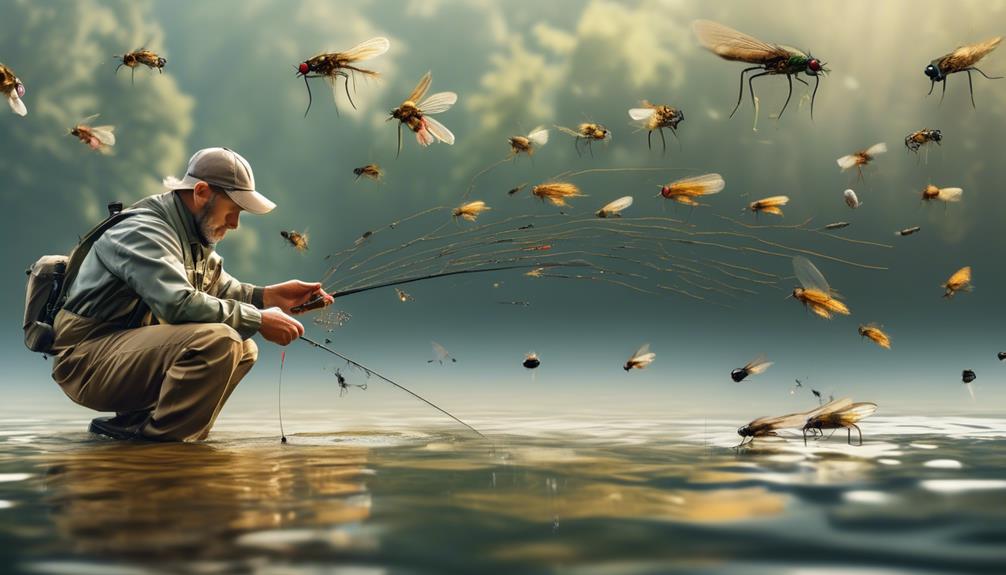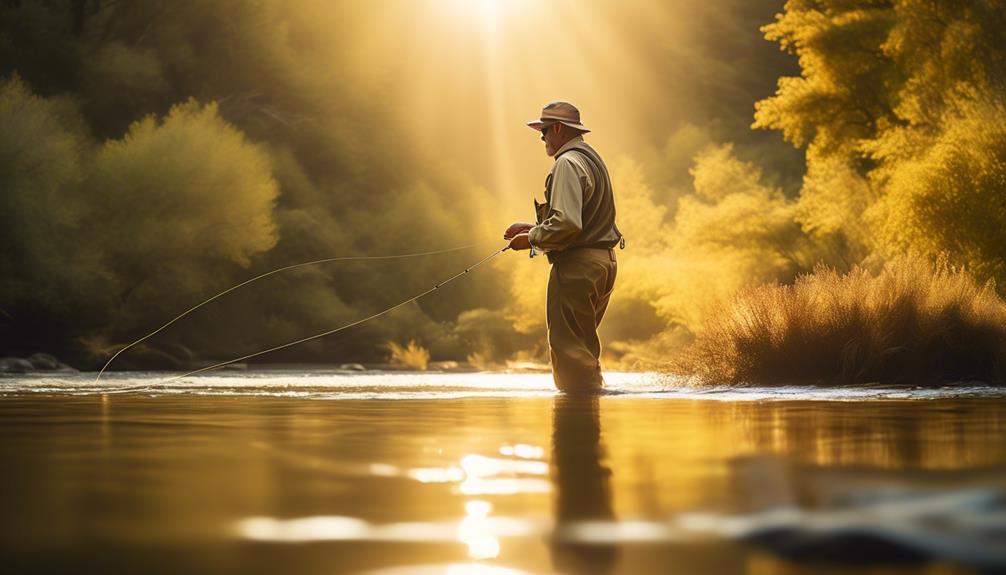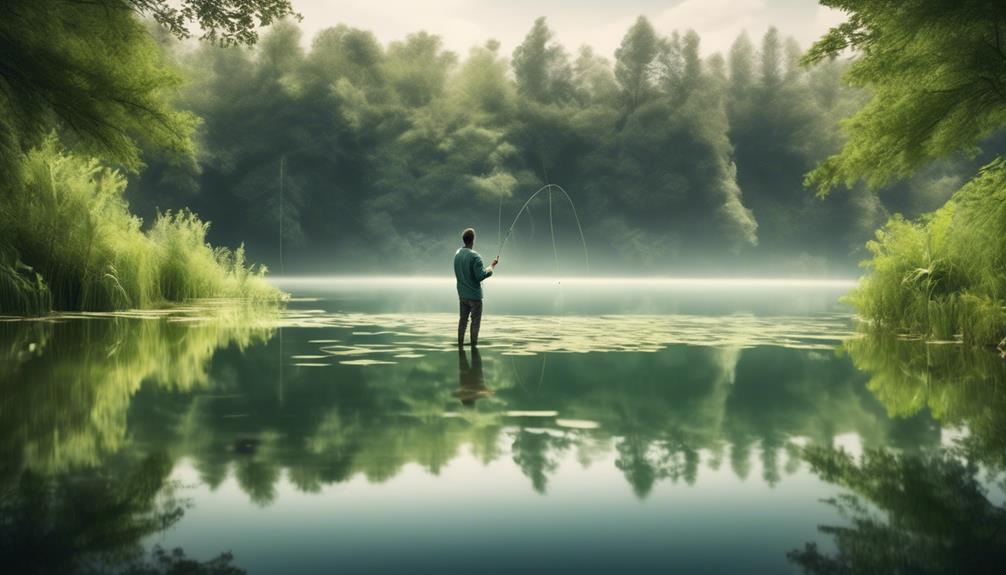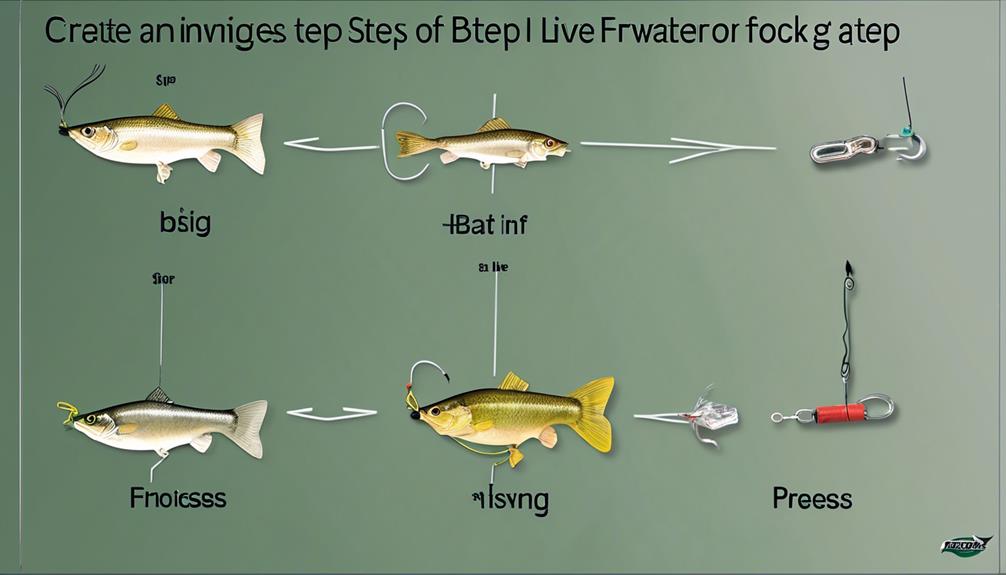When it comes to freshwater fly fishing, it's like trying to solve a complex puzzle where every piece matters. You're standing at the edge of a river, the sun glinting off the water, and you know that every decision you make will determine your success.
From selecting the right fly to understanding fish behavior, mastering the basic casts to reading the water, there are numerous techniques that can optimize your experience. But how do you ensure that you're using the right approach for each unique situation?
There's a wealth of knowledge waiting to be uncovered, and by exploring the intricacies of this art, you'll discover the key to unlocking success on the water.
Selecting the Right Fly
To catch more fish, you need to select the right fly for the conditions and the fish you're targeting. Fly selection is crucial in freshwater fly fishing as it directly impacts your chances of success. Understanding the fish feeding habits is key to choosing the appropriate fly. Different fish species have varied feeding behaviors, and your fly selection should align with these habits to entice the fish effectively.
Trout, for example, are known to be opportunistic feeders. They often target insects that fall onto the water's surface. In this case, dry flies that imitate these insects can be highly effective. On the other hand, if you're targeting bass, they're more aggressive and tend to go for larger prey such as minnows or small fish. Streamers or nymphs that mimic these types of prey can attract bass effectively.
Furthermore, understanding the stage of insect activity in the water is crucial. During a hatch, when insects are emerging, matching the hatch by using the appropriate fly pattern can significantly increase your chances of a successful catch. Additionally, considering the water conditions such as clarity and flow is necessary. In murky water, using flies with more prominent profiles and vibrant colors can help the fish notice your presentation.
Understanding Fish Behavior
Understanding fish behavior is essential for freshwater fly fishing success, as it directly influences the effectiveness of your fly selection and presentation. To optimize your fishing experience, it's crucial to grasp the following key points:
- Fish Feeding: Different species of fish have distinct feeding behaviors. Understanding what they're feeding on and how they're feeding will help you select the most appropriate fly patterns. For instance, trout are known to feed on aquatic insects, so imitating these insects with your fly pattern can significantly increase your chances of a successful catch.
- Habitat Preferences: Fish have specific habitat preferences, such as deep pools, rocky bottoms, or submerged vegetation. Knowing these preferences will guide you in locating the best spots to find fish. For example, bass tend to seek cover near submerged structures, so targeting these areas with precise fly presentation can lead to more bites.
- Reactive Behavior: Fish exhibit reactive behaviors to various stimuli, such as changes in light, water temperature, or the presence of predators. Being attuned to these reactions can help you adapt your fishing techniques accordingly.
- Daily Patterns: Fish often follow daily patterns in their behavior, such as feeding more actively during certain times of the day. Being aware of these patterns can help you plan your fishing trips to coincide with the most favorable times for catching fish.
Mastering the Basic Casts
Master the basic casts to improve your accuracy and control when freshwater fly fishing. Rod positioning and timing are crucial elements in executing a successful cast.
Start by holding the rod with your dominant hand and positioning it at a 10 o'clock angle with the line extended behind you. As you begin the forward cast, smoothly accelerate the rod to a 2 o'clock position, releasing the line at the right moment to achieve maximum distance and accuracy. The timing of your cast is essential for delivering the fly to the desired target.
Line control plays a significant role in achieving accuracy. As you make your cast, focus on controlling the line's trajectory and speed to ensure it lands precisely where you intend. Practice your wrist and arm movement to gain better control over the line, allowing you to adjust the direction and distance of your casts with ease. By mastering line control, you can effectively place your fly in the most promising fishing spots, increasing your chances of a successful catch.
Understanding the mechanics of rod positioning, timing, and line control will enhance your casting abilities, ultimately leading to improved accuracy and overall performance during freshwater fly fishing. Keep practicing these fundamental casts to develop your skills and become a more proficient angler.
Reading the Water
Reading the water is essential for a successful freshwater fly fishing experience, as it allows you to identify prime fishing spots based on the natural indicators present. Understanding the dynamics of the water body and its inhabitants is crucial for a fruitful fishing venture.
Here's how you can effectively read the water:
- Water Currents and Fish Feeding: Pay attention to the flow of the water. Observe areas where the current slows down, as these are often hotspots for fish feeding. Look for swirling eddies, seams, and pockets where fish tend to gather to feed.
- Fly Placement: Once you've identified the areas where fish are likely to be feeding, consider how to place your fly. Cast your fly slightly upstream of the feeding zone and let it drift naturally with the current. This mimics the movement of natural prey and increases the chances of a successful strike.
- Depth Variations: Different fish species prefer varying depths of water. Look for areas with depth variations such as drop-offs, submerged rocks, or changes in riverbed composition. These variations can concentrate fish at specific depths, making it easier to target them effectively.
Using the Proper Gear
To optimize your freshwater fly fishing experience, ensure that you have the proper gear to match the specific conditions of your chosen fishing location. Gear maintenance is crucial to ensure that your equipment functions at its best. Before heading out, inspect your fly rod, reel, and lines for any signs of damage or wear. Clean them regularly to prevent dirt and debris from impacting their performance. It's also essential to check and maintain your flies, leaders, and tippets. Replace any worn-out or damaged components to avoid any issues while fishing.
When it comes to rod selection, consider the type of water and fish you'll be targeting. For smaller streams or rivers, a lighter rod (3-5 weight) is often more suitable, as it provides better control and delicate presentations. In contrast, larger rivers or windy conditions may require a heavier rod (6-8 weight) to cast larger flies and handle bigger fish more effectively. Additionally, the action of the rod, whether it's fast, medium, or slow, should align with your casting style and the specific fishing situation.
Having the proper gear isn't only about selecting the right equipment but also about maintaining it to ensure optimal performance. By paying attention to gear maintenance and selecting the appropriate rod, you can enhance your freshwater fly fishing experience and increase your chances of success on the water.
Presentation and Drift Control
Improving your presentation and drift control is essential for successfully enticing and catching freshwater fish while fly fishing. To optimize your freshwater fly fishing techniques, here are some key strategies to enhance your presentation and drift control:
- Line Mending: Mastering the art of line mending is crucial for manipulating the drift of your fly. By using mends, such as the reach mend or the stack mend, you can adjust the position of your fly on the water, ensuring a natural and drag-free drift.
- Line Control: Maintaining control over your line is essential for a precise presentation. Keeping the line taut while avoiding excessive slack will allow for better sensitivity when detecting strikes and improved hook sets.
- Weighted Flies: Utilizing weighted flies can aid in controlling the depth and speed of your presentation. By adjusting the weight of your flies, you can effectively target different water depths and currents, increasing your chances of enticing fish.
- Fly Placement: Paying close attention to the placement of your fly is crucial for a convincing presentation. Understanding the behavior of the fish and the structure of the water will help you strategically position your fly to maximize its appeal.
Matching the Hatch

When matching the hatch, pay close attention to the size and color of the insects present on the water's surface to select the most effective fly pattern. Imitating insects that are already present in the water is crucial for a successful freshwater fly fishing experience. Insects go through various life stages, and each stage presents an opportunity for fly fishing. By observing the types of insects in the area, you can select the appropriate fly patterns to mimic their appearance and behavior, increasing your chances of a successful catch.
Different insects have different sizes and colors, and it's essential to closely match these characteristics with your fly patterns. For example, if you notice that the insects on the water are small and dark-colored, it would be wise to use a fly pattern that imitates these attributes. Similarly, if the insects are larger and have a lighter color, selecting a fly pattern that closely resembles these features would be most effective.
Understanding the life cycles of insects can also help in determining the appropriate fly pattern to use. For instance, if you notice that the insects are in their nymph stage, using a nymph pattern would be more effective than using an adult dry fly pattern. Observing the behavior of the insects, such as how they move on the water's surface, can further guide your choice of fly patterns.
Nymphing Techniques
Consider adjusting your nymphing technique to effectively target fish in varying water conditions and depths. To optimize your freshwater fly fishing experience, focus on mastering the following nymphing techniques:
- Line Control: Proper line control is crucial for nymphing. Ensure that you have a good drift by managing your line to reduce drag and maintain contact with your flies. Adjust your line to match the speed of the current and the depth of the water to improve your chances of enticing a strike.
- Weight Placement: Experiment with the placement and amount of weight on your leader to achieve the ideal depth. By adjusting the weight placement, you can effectively get your nymphs down to the feeding zone where the fish are actively foraging.
- Indicator Placement: Utilize indicators to detect strikes. Proper placement of the indicator is essential for detecting subtle takes. Ensure that your indicator is visible and sensitive enough to react to any slight movement indicating a fish has taken the nymph.
- Drag Management: Minimize drag on your nymphs by mending your line as needed. By managing the drag, you can present your nymphs naturally, mimicking the movement of aquatic insects and increasing your chances of enticing a bite.
Frequently Asked Questions
How Can Weather Patterns and Conditions Affect Freshwater Fly Fishing Success?
Weather patterns and conditions have a significant impact on freshwater fly fishing success. Wind can affect casting accuracy, while temperature influences fish behavior. Understanding barometric pressure can lead to better fishing results by predicting fish activity.
What Are Some Common Mistakes to Avoid When Fishing in Freshwater With Flies?
When fishing in freshwater with flies, avoid common mistakes like improper casting and failing to consider water conditions. Ensure you're not spooking the fish. Practice proper casting techniques and be mindful of your surroundings.
Are There Specific Strategies for Fishing in Different Types of Freshwater Environments, Such as Rivers, Lakes, or Streams?
When fly fishing in ponds, focus on casting near the edges where fish tend to gather. In reservoirs, try fishing near inflows or outflows where there's more oxygen and food. Vary your retrieval speed for better results.
How Can Anglers Effectively Target Specific Freshwater Fish Species With Fly Fishing Techniques?
To effectively target specific freshwater fish species with fly fishing techniques, focus on fly selection and casting accuracy. Consider water temperature and fish behavior to determine the best approach for a successful catch.
What Are Some Advanced Techniques for Controlling the Drift and Presentation of the Fly in Freshwater Fly Fishing?
To optimize your freshwater fly fishing, focus on advanced casting, mending techniques, and optimal retrieval methods. These will enhance presentation accuracy and drift control, giving you an edge in catching elusive fish.
Conclusion
Now that you've learned the techniques to optimize freshwater fly fishing, it's time to put them into practice.
Remember to:
- Select the right fly
- Understand fish behavior
- Master basic casts
- Read the water
- Use proper gear
- Control presentation and drift
- Match the hatch
With these skills in your arsenal, you'll be well-equipped to have a successful and enjoyable fly fishing experience on freshwater.
Happy fishing!



